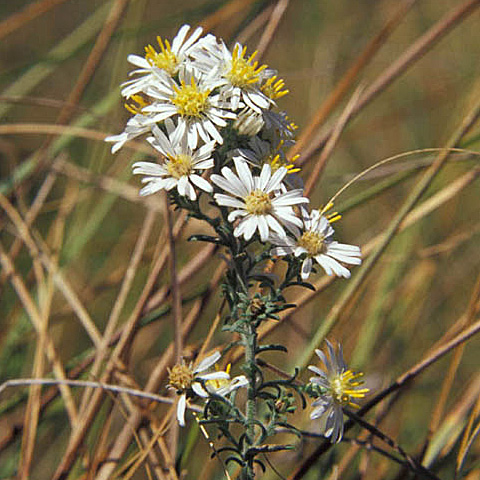Plants colonial, sometimes ± cespitose, usually densely hairy; long-rhizomatous (stems single) or short-rhizomatous with rhizomes branched and entangled (stems clumped), new shoots developing at ends of elongate rhizomes. Stems usually 1, sometimes 1-5+. Peduncles stout, bracts 2-10+. Phyllaries ± unequal, apices strongly squarrose. 2n = 30.
Flowering Aug-Oct(-Nov, south). Dry soils, plains, hills, prairies, roadsides, along railroad rights-of-way, stream banks; 200-2500+ m; Alta., Man., Ont., Sask.; Ariz., Colo., Ill., Iowa, Kans., Minn., Mo., Mont., Nebr., N.Mex., N.Dak., Okla., S.Dak., Tex., Utah, Wis., Wyo.; Mexico (Chihuahua, Coahuila, Durango, Jalisco, Nuevo León, Sonora).
Variety commutatum is introduced in Ontario, Illinois, Missouri, and Wisconsin, and possibly other eastern states. A. G. Jones (1978) treated it as a subspecies with two varieties on the basis of habit and head traits. Variety commutatum in the sense of Jones has decumbent or ascending stems usually branched proximally, heads in racemiform or diffuse paniculiform arrays, rarely secund, usually with 40-50(-60) florets. Variety crassulum in the sense of Jones has erect stems branched near the middle, with spreading branches, heads in paniculiform arrays, often somewhat secund, and with 35-40(-45) florets. Intermediates occur; Jones´s varieties are not recognized here.
The name Aster ramulosus Lindley var. incanopilosus Lindley (in W. J. Hooker 1834) has priority at the varietal level; the combination in Symphyotrichum has yet to be made.
Duration: Perennial
Nativity: Native
Lifeform: Forb/Herb
General: Herbaceous perennials, to 60 cm tall, stems appressed-pubescent, spreading, at least above the middle, plants with long rhizomes.
Leaves: Alternate, sessile or subsessile, linear, to 4 cm long, margins entire, densely strigose.
Flowers: Heads radiate, rays white, 4-5 mm long, disk flowers yellow, involucres graduated, 5-8 mm high, phyllaries strongly to weakly overlapping with rhombic, herbaceous tips, heads numerous and small, occurring on branch tips.
Fruits: Achenes appressed-pubescent. Pappus of numerous, tawny, sub-equal capillary bristles.
Ecology: Found on alluvial soils, mostly in the pine belt, from 3,500-8,000 ft (1067-2438 m); flowering August-October.
Distribution: Nebraska south to New Mexico and Texas, east to Tennessee and Virginia.
Notes: Look for this species under Aster commutatus in the older texts. Good identifiers for this species are the white rays, numerous, small heads, and the non-glandular, rhombic-tipped phyllaries in several series.
Ethnobotany: The ground blossoms were mixed with yucca suds and used to wash newborn infants for strength and to make their hair grow.
Etymology: Symphyotrichum comes from Greek symphysis for borne together and trichnos for hair, while falcatum means sickle-shaped and commutatum means changing.
Synonyms: Aster commutatus, Symphyotrichum falcatum var. crassulum, Aster adsurgens, Aster commutatus var. crassulus, Aster crassulus, Aster falcatus var. crassulus, many others, see Tropicos
Editor: LCrumbacher 2011








